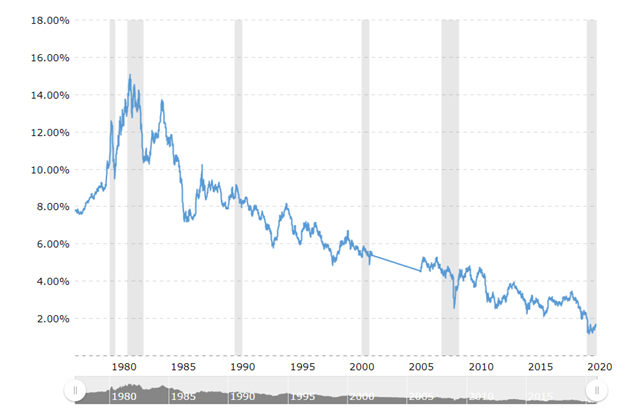

Vanguard’s extended duration treasury ETF is down to yielding 1.61%. It’s short term bond et yields only 0.36%. Inflation protected security products have a yield of NEGATIVE 1.15%. Even the mortgage back security product is yielding a paltry 1.22%.
Corporate bonds are not any better, with high grade corporate bonds yielding 0.84% and total return bonds products (e.g. partially junk) only yielding 3.06%. There are no money market products that have any return beyond something negligible. Many now offer disclaimers that there is no chance such products can keep up with inflation.
This means any investor placing money into a traditional 60/40 style portfolio is guaranteeing poor performance. If interest rates go up, their bonds will suffer. If interest rates stay flat, they’ll lose on inflation. And no one believes rates can go much lower (if they go negative, everyone just goes to cash).
So, what is the average investor to do?
When my clients ask me the question, the only investment left is the alternative investment class. This can take the form of:
- Private funds;
- Options strategies; or
- Real estate.
Over the next couple of weeks, each of these will be examined in detail and discuss how investors might profit from participating in each. A brief overview of each is included below.
Private Funds can access higher yielding products than may otherwise be available. For instance, my firm has a mortgage product that yields between 8%-10%, without significantly more risk than the several publicly traded mortgage ETFs. There are private funds that take advantage of tax lien strategies that have relatively safe risk that return anywhere from 5% to 10%. There are hard money lending funds that have higher risk, but they do offer returns commensurate with the risk. Some of these funds even offer different tiers of investment, depending on the return you’re seeking.
There are low risk option strategies which can consistently yield 5% to 7%. Increasing risk can increase these returns. For instance, there are dividend capture strategies which consistently yield 0.5% or so a month. The goal in a dividend capture strategy is to identify a stock, paying a dividend, buy the stock, sell a call at the current price that expires after the ex-dividend date and buy a put at the same price. The cost of the call and put needs to be LESS than the dividend being issued. There are regularly such opportunities. You won’t get rich doing it, but you can make a yield better than what else is available.
The last option for yield is of course real estate – own real estate, generate rent income. Unfortunately, it is not quite that simple, but even in the times of COVID-19, there are opportunities on both the residential and commercial side to find investments that have acceptable yields.
Government bonds, treasuries, and corporate bonds simply do not offer value to investors in the current interest rate and yield environment. Investors seeking yield must look elsewhere. Fortunately, there are products that can deliver positive returns if investors know where to look.
Christopher Welsh is a licensed investment advisor in the State of Texas and is the president of an investment firm, Lorintine Capital, LP which is a general partner of three separate private funds. He is also an attorney practicing in Dallas, Texas. Chris has been practicing since 2006 and is a CERTIFIED FINANCIAL PLANNER™. Working with a CFP® professional represents the highest standard of financial planning advice. He offers investment advice to his clients, both in the law practice and outside of it. Chris has a Bachelor of Science in Economics, a Bachelor of Science in Computer Science from Texas A&M University, and a law degree from Southern Methodist University. Chris manages the Anchor Trades portfolio and oversees Lorintine Capital's distressed real estate debt fund.
Related articles






There are no comments to display.
Create an account or sign in to comment
You need to be a member in order to leave a comment
Create an account
Sign up for a new account. It's easy and free!
Register a new account
Sign in
Already have an account? Sign in here.
Sign In Now